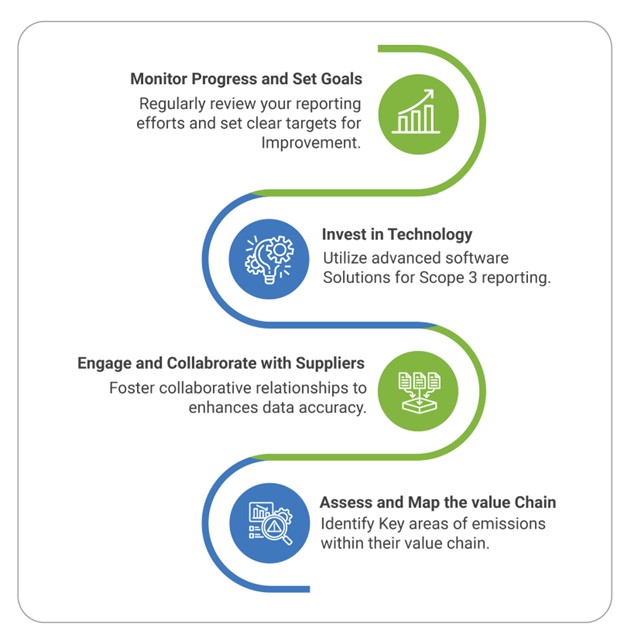Elevating Corporate Sustainability: The Competitive Advantage of Robust Scope 3 Emissions Reporting

Why Scope 3 Emissions Matter for Environmental and Business Success
In today’s sustainability-focused business environment, organisations face growing expectations to account for Scope 3 emissions—the indirect emissions within a company’s value chain that typically make up a significant portion of their carbon footprint. Unlike Scope 1 (direct emissions from owned sources) and Scope 2 (indirect emissions from purchased energy), Scope 3 emissions encompass all other indirect emissions related to a business’s operations. These emissions, covering around 70-90% of a company’s total emissions (World Economic Forum , 2023), span a wide range of activities such as purchased goods, transportation, employee commuting, waste disposal, and use of sold products.
Scope 3 emissions are divided into 15 categories (GHG Protocol ), with eight upstream categories (before product sales) and seven downstream categories (post-sales), reporting which can seem daunting. However, in light of growing environmental compliance requirements, such as the European Union’s Carbon Border Adjustment Mechanism (CBAM) and India’s Business Responsibility and Sustainability Reporting (BRSR), companies must improve their Scope 3 emissions reporting in order to stay competitive, meet regulatory standards, and maintain their market presence.
Navigating Scope 3 Reporting: Challenges and Practical Solutions
One of the greatest challenges in Scope 3 reporting is the availability and quality of data. In sectors like manufacturing, companies often have to rely on hundreds, if not thousands, of suppliers for emissions data. Suppliers play a key role, but the task of chasing suppliers for accurate emissions data can be arduous, especially when they lack standardised reporting practices. Establishing collaborative relationships with suppliers to share best practices for emissions data collection can help alleviate these challenges significantly.
Technology also plays a critical role in overcoming these data challenges. Globally, there are many software options for assessing Scope 3 emissions, including well-known products from SAP and Salesforce . Advanced digital platforms streamline data collection, integrate with existing enterprise systems, and provide real-time insights. In-house customised software solutions, as used by certain conglomerates, can also help track and manage emissions.
Another challenge in Scope 3 reporting is to apportion the emissions when a supplier serves multiple clients. A cost-based approach is the most commonly used method for allocating emissions, assigning them based on the monetary value of goods purchased. While this approach is widely used, it may not fully capture the sustainability measures embedded within certain products or services. For example, a supplier may use energy-efficient processes or environmentally friendly materials that reduce the overall carbon footprint, but these nuances might not be accounted for in a purely cost-based system.
To overcome this limitation, some companies have adopted a hybrid approach. This method combines the cost-based model with product-specific emission factors, offering a more accurate reflection of the environmental impact. By using specific data related to the carbon intensity of different products or materials, companies can more precisely apportion emissions and ensure that their sustainability initiatives are acknowledged.
Stay Ahead: The Business Benefits of Scope 3 Reporting
Reporting Scope 3 emissions is more than just a matter of compliance; it is also a strategic step for future competitiveness. As of 2023, an estimated 51% of India’s top 100 listed companies by market capitalisation voluntarily disclosed Scope 3 data (PWC India ), despite the BRSR framework making it optional. Companies like Tata Steel , JSW, and Ultratech Cement have started using Environmental Product Declarations (EPDs) as part of their emissions transparency efforts, setting an example for others.
With global rules tightening, organisations that report transparently and invest in Scope 3 reporting systems and supply chain collaboration gain a competitive advantage, lower potential financial risks, and maintain a positive corporate brand in increasingly environmentally concerned markets. To capitalise on these benefits, organisations can take the following
Actionable steps:
 By being transparent about their value chain emissions, firms can attract environmentally conscious investors and customers, maintain growth in low-carbon markets, contribute positively to global climate targets and be ahead of the game.
By being transparent about their value chain emissions, firms can attract environmentally conscious investors and customers, maintain growth in low-carbon markets, contribute positively to global climate targets and be ahead of the game.
[1] Article by The World Economic Forum
[2] Scope 3 Calculation Guidance, GHG Protocol
[3] Salesforce Scope 3 cloud based software
[4] PwC India report titled, “Navigating India’s Transition to Sustainability Reporting.”
[5] Press release by Tata Steel
Disclaimer: The opinions expressed in this article are those of the authors and do not purport to reflect the views of AEEE
This blog is written by Rohan Kadamb




